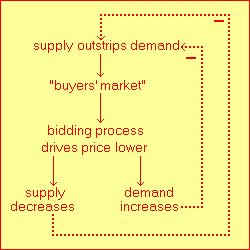| Such a surplus—that is, an excess of supply relative to demand—creates a temporary "buyers' market." Some sellers are willing to accept bargains beneath the prevailing per-unit price, because the lower price they accept still has more marginal utility to them than the units they are selling. Buyers, meanwhile, maximize their utility by taking advantage of these better deals. In this case, the bidding process generates a decrease in the prevailing market price. As the market price is driven downward, supply decreases and demand increases until the equilibrium point is reached. The negative-feedback loops can again be traced in the diagram at right.
Thus in the free market a price that is either above or below the equilibrium point is inherently unstable, gravitating quickly toward the stable point of equilibrium. Similarly, any shortages and surpluses are quickly rectified, as the bidding process resolves any discrepancies between supply and demand ( ). ).  |
|
 |
![]() ).
). ![]()
